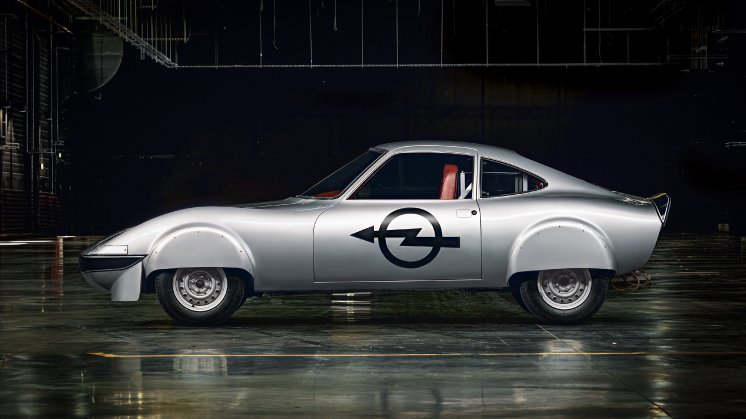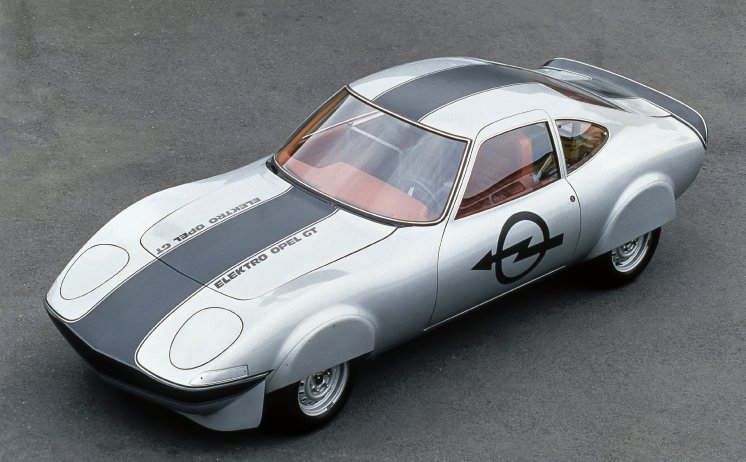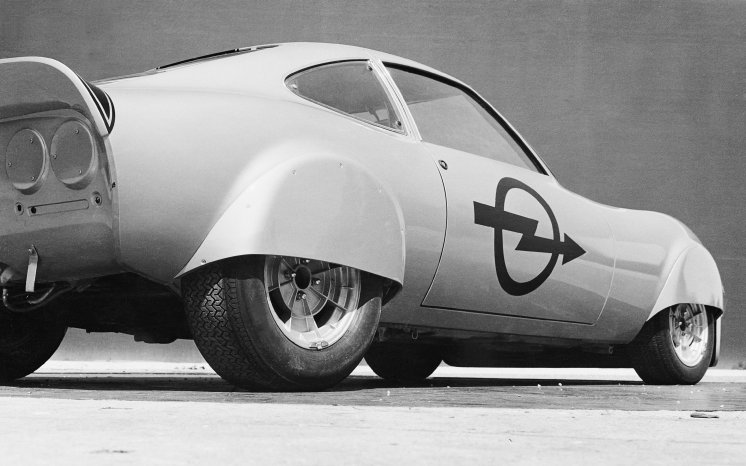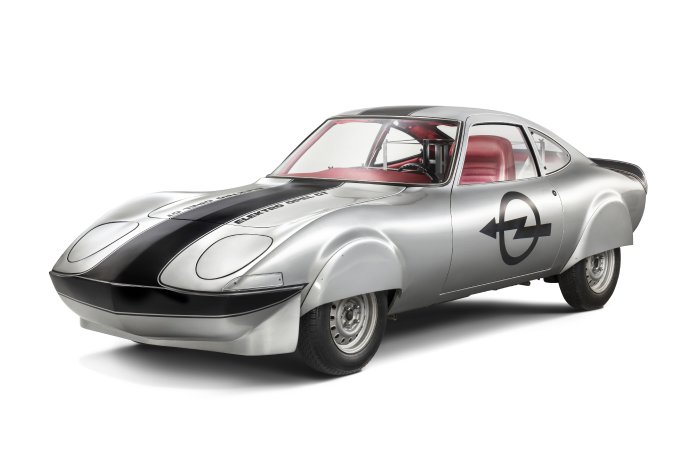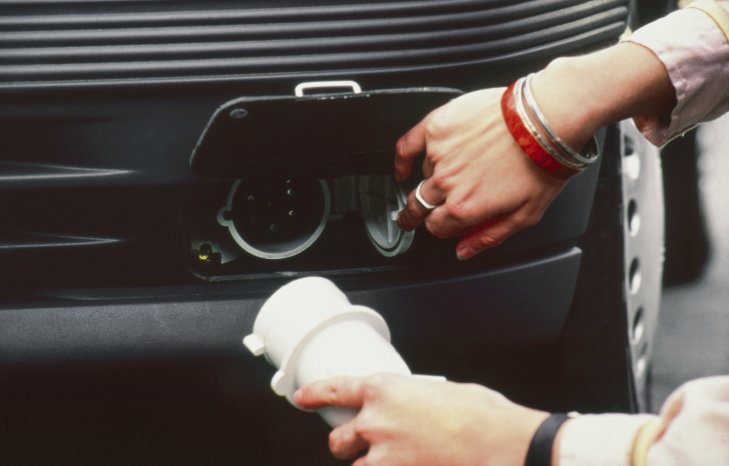- E-pioneers: the ancestors of Opel Corsa-e and Grandland X plug-in hybrid
- Since 1968: more than five decades of research into electric propulsion systems
- Way ahead of its time: Opel Ampera
- HydroGen test fleets: hydrogen fuel cell propulsion has high future potential
- Opel goes electric: all models electrified by 2024
Already back in 1968, the Kadett B Stir-Lec I featured the principle of the “range extender” that would later go into production with the Opel Ampera. The Stir-Lec study was powered by 14 lead-acid batteries and the electricity that kept the batteries constantly charged was generated by a rear-mounted Stirling combustion engine.
Only three years later, Georg von Opel, the grandson of the company founder, broke six electric vehicle world records at the wheel of a 188 km/h Opel Electro GT powered by two coupled electric motors producing 88 kW/120 hp. Energy was supplied by a 590 kilogramme nickel-cadmium battery pack and at a constant speed of 100 km/h, the car had a range of 44 kilometres.
Sustainable electric impulse: Opel Impuls and Opel Twin
Research took a step forward with the Opel Impuls programme during 1990-97. Impuls I was a Kadett-based vehicle powered by a 16 kW direct-current electric motor using nickel-cadmium battery cells with a liquid electrolyte. It had a range of around 80 km and a top speed of 100 km/h. This was followed a year later by Impuls II, based on an Astra estate. It used 32 lead-acid batteries to power two three-phase asynchronous motors giving a total of approximately 45 kW/61 hp. From 1993 to 1997, Opel carried out its first large-scale electric vehicle test program with Impuls III. A fleet of ten Impuls III cars was tested on the German island of Rügen, covering a total of more than 300,000 km. Five vehicles were fitted with nickel-cadmium batteries (45 kW/61 hp) and the other five used sodium/nickel-chloride high-energy batteries (42 kW/57 hp). All ten Impuls III vehicles were equipped with a three-phase asynchronous motor.
Meanwhile, in 1992 the widely acclaimed Opel Twin concept car was revealed. A three-cylinder, 0.8-litre petrol engine delivering 25 kW/34 hp was available for highway driving, while an electric unit with two 10 kW/14 hp wheel-hub motors came into play for city and short-distance driving. The Opel Twin driver had a central forward position, with three passenger seats in the back. In 1995, Opel took electro-mobility into the commercial vehicle segment with the Combo Plus concept van, which featured two sodium/nickel-chloride high-energy batteries operating in combination with a 45 kW three-phase asynchronous motor.
Fuel cells in everyday testing: emission-free HydroGen fleets
In 2000, Opel’s fuel-cell development took to the streets with the Zafira-bodied HydroGen1. Its hydrogen fuel cell supplied electricity for a three-phase asynchronous motor giving 55 kW/75 hp and 251 Nm of torque. A buffer battery covered power peaks. In 2001, a fleet of 20 HydroGen3 models was driven by test customers. Power was increased to 60 kW/82 hp, giving a top speed of 160 km/h. In the 2004 Fuel Cell Marathon, two HydroGen3 vehicles covered nearly 10,000 km across Europe, from Hammerfest in Norway to Lisbon in Portugal. At the wheel of a HydroGen3, Grand Prix and Opel DTM driver Heinz-Harald Frentzen also won the 2005 Monte Carlo Rally for cars with alternative propulsion.
The fourth generation of fuel cell vehicles, HydroGen4, is also completely emission-free, with only water vapour coming out of the exhaust. The fuel cell stack consisting of 440 cells connected in series, in which hydrogen reacts with oxygen from the air, is responsible for the environmentally friendly drive. There is no combustion, but an electrochemical reaction that generates electricity. In this way, a continuous output of 73 kW/100 hp and a peak output of 94 kW/128 hp are possible. Starting in 2008, a fleet of HydroGen4 vehicles began demonstrating its suitability for everyday use in a project sponsored by the Federal Ministry of Transport – the Clean Energy Partnership (CEP) – in Berlin and later also in the states of Hamburg, Baden-Württemberg, North Rhine-Westphalia and Hesse.
Range champions: Opel Ampera with range extender and Opel Ampera-e
At the same time, Opel also pursued the development of battery-powered vehicles and presented the innovative Flextreme Concept at the 2007 IAA in Frankfurt, which featured the Voltec extended-range electric propulsion. The Flextreme GT/E Concept, presented at the 2010 Geneva Motor Show, illustrated how this drive concept can also be integrated into a mid-size car.
The electric drive with range extender reached series production in 2011 in the Opel Ampera, the first electric car for four people fully suitable for everyday use and travel. The energy for distances between 40 and 80 kilometres (depending on driving conditions) was supplied by the 16 kWh lithium-ion battery, which fed the 111 kW/150 hp electric motor. Whenever the battery charge level reached a defined minimum, the 63 kW/86 hp petrol engine switched on automatically and drove a generator to power the electric motor. This type of continuous energy supply ensures carefree driving – without a charging station and with ranges of several hundred kilometres. The Ampera was ahead of its time and was awarded the “European Car of the Year 2012” title.
The Opel Ampera-e followed in 2016/2017. With a segment-leading pure electric range of 423 kilometres (WLTP), the Ampera-e debuted as a true range champion at the Paris Motor Show. Since the batteries are mounted extra flat in an underfloor design, it offers space for five passengers and a boot with the capacity of a full-size five-door compact class model (381 litres). The Ampera-e also demonstrates how electric mobility and driving pleasure can form a single unit, as the maximum torque of 360 Nm ensures impressive acceleration and elasticity values. The output of the electric motor is 150 kW/204 hp. The compact car accelerates from zero to 50 km/h in 3.2 seconds, and covers the intermediate sprint from 80 to 120 km/h when overtaking in just 4.5 seconds.
It is a convincing concept: in autumn 2017, Opel was awarded the internationally renowned “Golden Steering Wheel” in the small and compact car class for the Ampera-e. And the AUTOBEST jury had already voted the Ampera-e ECOBEST 2016. Opel dealers still have a few Ampera-e, but their place in the showroom will soon be taken by the new Corsa-e, which has already won the AUTOBEST “Best Buy Car of Europe” award.
